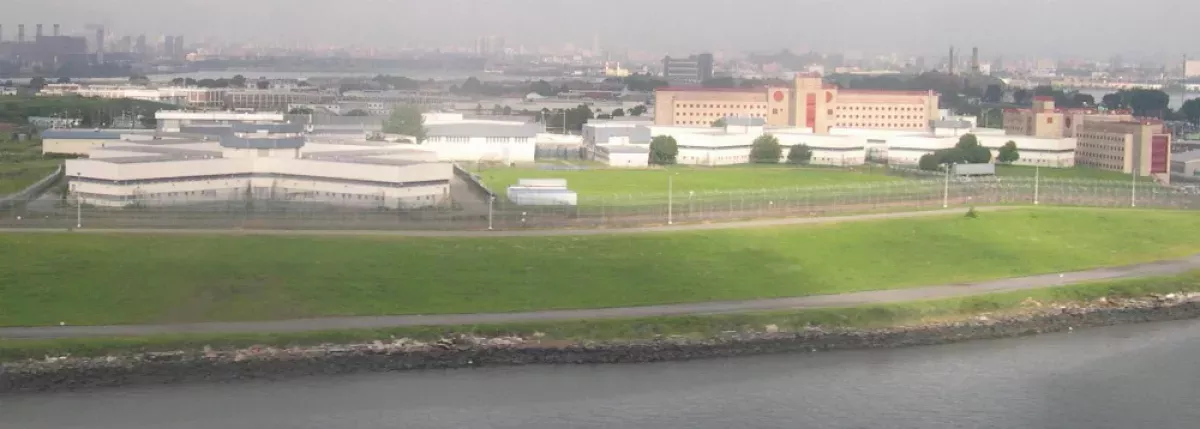Rikers Island is a 413-acre prison complex situated on an island in the East River, Bronx, New York City. It serves as New York City's main jail complex. Known for overcrowding, violence, and allegations of inmate abuse, it has faced significant criticism and calls for reform and closure. The facility has a long history of controversy, stemming from its conditions and treatment of inmates. There are ongoing plans for its eventual closure.
1908: City Expressed Desire to Open Jail
In 1908, the city expressed a desire to open a jail for men on Rikers Island to replace their overburdened jail on Welfare Island.
1922: City Banned From Ocean Dumping
In 1922, New York City was banned by the courts from dumping garbage in the ocean, leading to increased garbage accumulation on Rikers Island.
1932: Jail Opened
In 1932, the jail on Rikers Island was officially opened.
1934: Warden Describes Fires
In 1934, a warden described the spontaneous phosphorescent fires on Rikers Island due to the ash from coal heating and incinerators creating a beautiful scene at night.
1935: Original Penitentiary Building Completed
In 1935, the original penitentiary building on Rikers Island, called HDM (House of Detention for Men), was completed.
1939: North Beach Airport Opened
In 1939, 200 acres were stripped from Rikers Island to help fill in the new North Beach Airport, later renamed LaGuardia Airport.
1939: Robert Moses Cleans Up Island
In 1939, Robert Moses organized the cleanup of Rikers Island and redirected the city's garbage to the Fresh Kills Landfill on Staten Island, to improve the backdrop for the World's Fair.
1943: Landfill Expansion Completed
Landfill was added to Rikers Island until 1943, enlarging the island to 415 acres.
February 1, 1957: Northeast Airlines Flight 823 Crashes
On February 1, 1957, Northeast Airlines Flight 823 crashed onto Rikers Island shortly after departing LaGuardia Airport, killing 20 and injuring 78. Inmates assisted with the rescue effort, leading to reduced sentences for some.
1965: Dalí Drawing Hung in Dining Room
From 1965, a drawing by Salvador Dalí, intended as an apology for missing a talk about art for prisoners, hung in the inmate dining room in J.A.T.C. (HDM).
November 1966: Francis Buono Bridge Dedicated
In November 1966, the 4,200-foot three-lane Francis Buono Bridge, providing road access to Rikers Island from Queens, was dedicated by Mayor John Lindsay.
1981: Drawing Moved for Safekeeping
In 1981, the Salvador Dalí drawing was moved from the inmate dining room to the prison lobby in E.M.T.C. (C76) for safekeeping.
1986: Federal Appeals Court Rules Against Strip Searches
In 1986, a federal appeals court ruled that strip searches could not be performed on people arrested on misdemeanor charges, such as fare evasion on the subway, or marijuana smoking.
1989: Keel Laid for Vernon C. Bain Correctional Center
In 1989, the keel for the Vernon C. Bain Correctional Center (VCBC), an 800-bed barge, was laid at the Avondale Shipyard in New Orleans.
1991: Rikers Population Peak
Since 1991, the Rikers population has dropped by more than 50%, when the average daily population was 21,688.
1992: VCBC Opened
In 1992, the Vernon C. Bain Correctional Center (VCBC) opened for use as a facility after being towed from Louisiana to its current mooring.
1993: United Blood Nation Founded
In 1993, United Blood Nation was founded by Omar Portee and Leonard McKenzie while incarcerated at the George Mochen Detention Center at Rikers Island.
2000: James A. Thomas Center Closed
In 2000, the James A. Thomas Center, formerly the HDM, closed due to structural issues.
2001: Appeals court ruling on strip searches
In 2001, a United States Court of Appeals for the Second Circuit ruling stated that strip-searches of misdemeanor suspects were illegal, unless officials suspected that they were carrying contraband. Despite this ruling, the policy of strip searches continued.
2001: Ruling reinforces illegality of strip searches
In 2001, a ruling in New York reinforced the illegality of strip searches for misdemeanor detainees, demanding that the city pay up to $50 million to the tens of thousands of people who were illegally searched over the years.
2002: Court settlement regarding strip searches
In 2002, there was a court settlement, which was violated and led to the New York City Department of Corrections conceding that tens of thousands of nonviolent inmates had been wrongly strip-searched on October 4, 2007.
March 2003: Dalí Drawing Stolen
In March 2003, the Salvador Dalí drawing was stolen from Rikers Island and replaced with a fake. Correctional officers were arrested.
2003: Ferry Boats Sold for Salvage
Around 2003, two smaller 1950s-era Staten Island Ferry boats, converted to house inmates, were sold for salvage.
December 2005: "Gay housing" unit closed
In December 2005, the segregated unit at Rikers for LGBT prisoners, known as "gay housing", was closed, citing a need to improve security. The unit had opened in the 1970s due to concerns about abuse of LGBT prisoners in pretrial detention.
October 4, 2006: Assault cover-up at Robert N. Davoren Center
On October 4, 2006, Captain Sherman Graham allegedly assaulted an inmate at the Robert N. Davoren Center (RNDC) after the inmate refused to comply with strip searching procedures. Graham and Assistant Deputy Warden Gail Lewis were later arrested on June 1, 2007, for covering up the assault.
October 2006: DOI Investigation Started
In October 2006, the Department of Investigation (DOI) received a tip following an anti-corruption presentation at the academy, which led to an investigation into the assault cover-up at Robert N. Davoren Center. This ultimately led to the arrest of Captain Sherman Graham and Assistant Deputy Warden Gail Lewis on June 1, 2007.
June 1, 2007: Arrest of Captain and Assistant Deputy Warden
On June 1, 2007, Captain Sherman Graham and Assistant Deputy Warden Gail Lewis were arrested for covering up an assault on an inmate at the Robert N. Davoren Center (RNDC) on October 4, 2006. The arrests came after they were indicted by a Bronx grand jury.
October 4, 2007: NYC Department of Corrections Concedes Wrongful Strip Searches
On October 4, 2007, the New York City Department of Corrections conceded that tens of thousands of nonviolent inmates taken to Rikers Island on misdemeanor charges had been wrongly strip-searched in violation of a 2002 court settlement, and were entitled to payment for damages.
February 2008: Correctional officer indicted for inmate abuse
In February 2008, correctional officer Lloyd Nicholson was indicted for allegedly using teenage inmates as enforcers under "the program" and for beating inmates himself.
July 2008: Alleged Rape Case at Rose M. Singer Center
In July 2008, an alleged rape occurred at the Rose M. Singer Center, where an inmate claimed to have been sexually assaulted with a dildo-like object after being bound and gagged in her cell. The incident was reported by The Village Voice on August 5, 2008.
August 5, 2008: Village Voice Reports Alleged Rape Case
On August 5, 2008, The Village Voice reported on an alleged rape case from July 2008 at the Rose M. Singer Center, where an inmate claimed she was sexually assaulted with a dildo-like object after being bound and gagged in her cell. The incident allegedly occurred sometime before 6 a.m. on July 3.
2008: Scandals at Rikers Island in 2008
In 2008, various scandals occurred at Rikers Island. These included officers allegedly passing marijuana, cigarettes, and alcohol to an accused cop killer; the February indictment of a correctional officer for using inmates as "enforcers"; and the April 27 suicide of an 18-year-old inmate.
February 4, 2009: Report on guard complicity in inmate violence
On February 4, 2009, The New York Times reported on a pattern of cases suggesting that correctional officials were aware of a problem involving guards encouraging violence among inmates at Rikers. At least seven lawsuits were filed accusing guards of complicity in inmate violence.
December 2009: Lewis Retirement
In December 2009, Lewis was able to retire with her pension before being found guilty and sentenced in 2012 for covering up the assault on an inmate.
May 14, 2012: Guilty verdict for Graham and Lewis
On May 14, 2012, Graham and Lewis were found guilty on all charges by a Bronx jury after approximately three hours of deliberation. They were involved in covering up an assault on an inmate.
August 7, 2012: Sentencing of Graham and Lewis
On August 7, 2012, Graham and Lewis were sentenced to 500 hours of community service and ordered to pay $1,000.00 in fines each. Previously, on May 14, 2012, they were found guilty on all charges.
August 18, 2012: Inmate death due to neglect of medical care
On August 18, 2012, inmate Jason Echevarria died after swallowing powdered detergent and being denied medical care. The medical examiner ruled the death a homicide due to neglect.
December 19, 2012: Ronald Spear demands to see a doctor
On December 19, 2012, Ronald Spear, a 52-year-old inmate awaiting trial with kidney failure, left his dormitory and demanded to see a doctor.
2012: Solitary confinement and mental health issues in 2012
In fiscal year 2012, the New York City Department of Correction reported that more than 14.4 percent of adolescents detained at Rikers Island between the ages of 16 and 18 were held in at least one period of solitary confinement while detained. The average length of time young people spent in solitary confinement at Rikers Island was 43 days. More than 48 percent of adolescents at this institution have diagnosed mental health problems.
May 2013: Worst Correctional Facilities
In May 2013, Rikers Island was ranked as one of the ten worst correctional facilities in the entire United States, according to a report in Mother Jones magazine.
June 2013: Bradley Ballard sent to Rikers
In June 2013, Bradley Ballard, who suffered from schizophrenia and diabetes, was sent to Rikers Island on a parole violation.
June 2013: Kalief Browder released
In June 2013, Kalief Browder was released by Judge Patricia DiMango after being imprisoned without trial for three years. The case was dismissed after numerous postponements and 31 hearings. Browder had been accused of stealing a backpack at the age of 16.
September 4, 2013: Ballard locked in cell
On September 4, 2013, Bradley Ballard was locked in his cell as punishment for making inappropriate gestures to a correctional officer.
2013: Reports of "serious injuries" in altercations with prison guards
In 2013, approximately 129 inmates, 77% of whom were mentally ill, suffered 'serious injuries' in altercations with prison guards over an 11-month period. These injuries exceeded the capacity of prison doctors to treat successfully.
January 2014: Rolando Perez death due to lack of seizure medication
In January 2014, Rolando Perez, who suffered from a seizure disorder, was found dead after being denied anti-seizure medication while in solitary confinement.
February 15, 2014: Jerome Murdough found dead in cell
On February 15, 2014, Jerome Murdough, a homeless veteran, was found dead in his cell from overexposure to heat, after being ignored by prison guards despite complaining about the temperature.
August 2014: Report on abuse of prisoners
In August 2014, US Attorney Preet Bharara issued a report condemning the systematic abuse and violation of prisoners' constitutional rights at Rikers Island. Also in August 2014, Bharara issued a damning report on the treatment of juvenile prisoners, identifying "a pattern and practice of conduct at Rikers that violates the constitutional rights of adolescent inmates", including excessive force, inadequate protection from violence, and heavy use of solitary confinement.
August 28, 2014: Law passed boosting oversight of solitary confinement
On August 28, 2014, a law was passed to enhance oversight of solitary confinement at Rikers Island, in response to public outcry over abuses at the prison. The law required quarterly reports on the use of solitary confinement, but lacked provisions protecting prisoners against brutality or limiting the use of solitary confinement as punishment.
September 29, 2014: Judge recommends firing of correctional officers
On September 29, 2014, Judge Tynia Richard recommended that six correctional officers be fired for the brutal beating of Robert Hinton, a mentally ill inmate, while he was hog-tied. The group of officers was led by Captain Budnarine Behari.
October 2014: Browder profiled in The New Yorker
In October 2014, Kalief Browder was profiled in The New Yorker for being held for three years on Rikers Island without a trial. He had been imprisoned after being accused of stealing a backpack.
December 2014: Terrence Pendergrass convicted
In December 2014, Terrence Pendergrass was convicted of denying inmate Echevarria medical care, resulting in death.
2014: De Blasio takes action against abuse
In 2014, Mayor de Blasio began to take action against abuse at Rikers Island by adding surveillance cameras and improving care for mentally ill prisoners.
June 6, 2015: Kalief Browder dies by suicide
On June 6, 2015, Kalief Browder died by suicide by hanging. The conditions of his detention were widely seen as having caused his mental condition. He had multiple prior suicide attempts while incarcerated.
June 2015: Terrence Pendergrass sentenced to prison
In June 2015, Terrence Pendergrass was sentenced to five years in prison for denying medical care to Jason Echevarria.
November 2015: Echevarria family awarded settlement
In November 2015, Jason Echevarria's family was awarded a $3.8 million settlement regarding his death.
2015: Rikers Budget and Population
In 2015, Rikers Island, operated by the New York City Department of Correction, had an $860 million budget, a staff of 9,000 civilian officers and 1,500 other civilians managing 100,000 admissions per year and an average daily population of 10,000 inmates.
2015: Transgender Housing Unit Opened
In 2015, city corrections officials opened what was then called the Transgender Housing Unit at Rikers Island. Three years later, spurred by LGBTQ+ advocates, the mayor's office announced that the Department of Correction would house incarcerated people consistent with their gender identity.
2015: Assaults Reach Five-Year High
In 2015, there were 9,424 assaults on Rikers Island, marking the highest number in five years.
January 25, 2016: Obama Criticizes Overuse of Solitary Confinement
On January 25, 2016, President Barack Obama wrote an article in The Washington Post criticizing the "overuse" of solitary confinement in American jails, basing his arguments largely on Kalief Browder's case. He also signed an executive order banning solitary confinement of juveniles in federal prisons.
February 2016: Lippman Commission Convened
In February 2016, the Independent Commission on New York City Criminal Justice and Incarceration Reform, known as the Lippman Commission, was convened to review the city's criminal justice system.
September 2016: Campaign March to Close Rikers
In September 2016, a campaign organized a march from Queens Plaza to the Rikers Island Bridge, calling for the closure of the complex.
November 2, 2016: Eugene Castelle sent to Rikers
On November 2, 2016, Eugene "Sonny" Castelle was sent to Rikers Island following an arrest in Florida.
November 2016: Construction on 1,500 Bed Facility Paused
In November 2016, New York City Department of Correction Commissioner Joseph Ponte announced a pause on the construction of a 1,500 bed facility on Rikers Island due to political considerations regarding the movement to close Rikers.
2016: Convictions and sentencings related to an incident
In 2016, Brian Coll was convicted and sentenced to 30 years in prison, Byron Taylor pleaded guilty to perjury and conspiracy to obstruct justice, and Anthony Torres pleaded guilty to conspiracy to obstruct justice and filing a false report.
2016: City agrees to settlement in lawsuit.
In 2016, the city agreed to pay $5.75 million to settle a lawsuit regarding the treatment of Bradley Ballard.
2016: Violence Increases
In February 2018, the New York State Commission of Correction issued a report citing numerous violations at Rikers Island and a significant increase in violent incidents from 2016 to 2017.
June 22, 2017: De Blasio Releases Shutdown Plan
On June 22, 2017, former Mayor de Blasio released his plan for a 10-year shutdown of the Rikers Island facility.
2017: Report Suggests Airport Expansion
According to a 2017 city-sponsored report, one possibility for reuse of Rikers Island after closure of the jail complex would be to build an expansion of nearby LaGuardia Airport.
2017: New York State Law Passed
In 2017, New York state passed a law requiring that juvenile inmates under 18 be housed separately from adults.
2017: Violence Increases
In February 2018, the New York State Commission of Correction issued a report citing numerous violations at Rikers Island and a significant increase in violent incidents from 2016 to 2017.
February 2018: Report Cites Violations and Violence Increase
In February 2018, the New York State Commission of Correction issued a report citing numerous violations at Rikers Island and a significant increase in violent incidents from 2016 to 2017.
2018: Juvenile Inmates Moved
In 2018, Rikers Island stopped housing juvenile inmates. This move was prompted by a New York state law passed in 2017 requiring that inmates under 18 be housed separately from adults.
June 7, 2019: Layleen Polanco dies in solitary confinement
On June 7, 2019, Layleen Xtravaganza Cubilette-Polanco, a transgender woman, died in solitary confinement at Rikers Island.
October 2019: City Council Votes to Close Rikers
In October 2019, the New York City Council voted to close down the Rikers Island facility by December 31, 2026.
October 17, 2019: City Council Votes to Close Prisons
On October 17, 2019, the City Council voted for an over $8 billion plan to close the Rikers Island prisons and other New York City jails by 2026, and replace them with four borough-based jails.
2019: Conversations about banning cash bail and pretrial detention
In 2019, Layleen Polanco's death reignited conversations about banning cash bail and pretrial detention. Polanco's sister and others called for banning solitary confinement in New York City after Polanco's death.
2019: Perez's girlfriend awarded a settlement
In 2019, Rolando Perez's girlfriend was awarded a $3.5 million settlement over his death.
March 22, 2020: Inmates strike over COVID-19 conditions
On March 22, 2020, two dorms of 45 inmates each carried out a strike protesting the lack of PPE, social distancing, and cleaning supplies. They demanded the release of inmates meeting Board of Correction criteria.
February 2021: The New York Times article criticizing pandemic handling
In February 2021, The New York Times featured an article by former inmate Michele Evans, who criticized Rikers Island's handling of the COVID-19 pandemic.
October 2021: Report of lawlessness and violence due to staff shortages
In October 2021, The New York Times reported that staff shortages, exacerbated by the COVID-19 pandemic, led to inmates virtually running the jail, resulting in lawlessness, violence, and chaos.
2021: Deterioration of Conditions and deaths reported
In 2021, Rikers Island experienced drastically deteriorated conditions due to COVID-19, staffing shortages, and mental health crises, resulting in 15 reported deaths of incarcerated people.
2021: Cost to Detain One Person
In 2021, an analysis by the New York City Comptroller determined that it cost the city approximately $556,539 to detain one person for one year at Rikers Island.
May 13, 2025: Federal Judge Orders Court Oversight
On May 13, 2025, federal judge Laura Taylor Swain ordered the Rikers Island complex to be run by an official reporting directly to the court due to the current management's inability to remedy long standing issues.
2026: Targeted closure of Rikers Island
On October 17, 2019, the City Council voted for an over $8 billion plan to close the Rikers Island prisons and other New York City jails by 2026, and replace them with four borough-based jails.
December 31, 2026: Planned Closure Date
The New York City Council voted to close down the Rikers Island facility by December 31, 2026.
Mentioned in this timeline

Barack Obama the th U S President - was the...

Christmas is an annual festival celebrated on December th commemorating...
Florida a state in the Southeastern United States is largely...

New Orleans is the most populous city in Louisiana and...

Epilepsy encompasses a range of neurological disorders marked by recurring...

Justice in its broadest sense is the concept of treating...
Trending

Joel Embiid a Cameroonian-American professional basketball player for the Philadelphia ers is a dominant force in the NBA Drafted third...

6 months ago Luke Bryan Celebrates Birthday; Announces Crash My Playa 2026 in Mexico

6 months ago Quentin Grimes' Free Agency Addressed Amidst 76ers' Changes and Contract Expectations.

Jared McCain is an American basketball player currently playing for the NBA's Philadelphia ers He previously played college basketball for...
Taylor Momsen is an American singer songwriter musician model guitarist and former actress She is known for her roles as...

3 months ago Jim Carrey's 'Grinch' gets 4K Steelbook release, plus outrageous performance streams on Tubi.
Popular

Stranger Things created by the Duffer Brothers is a popular...

XXXTentacion born Jahseh Dwayne Ricardo Onfroy was a controversial yet...
Turning Point USA TPUSA is an American nonprofit organization founded...

Candace Owens is an American conservative political commentator and author...

Melania Trump a Slovenian-American former model has served as First...

Bernie Sanders is a prominent American politician currently serving as...
